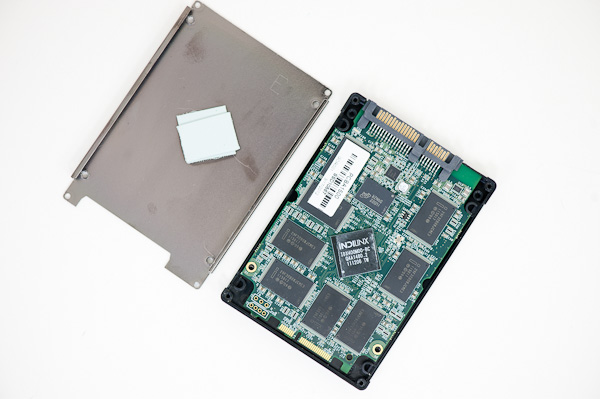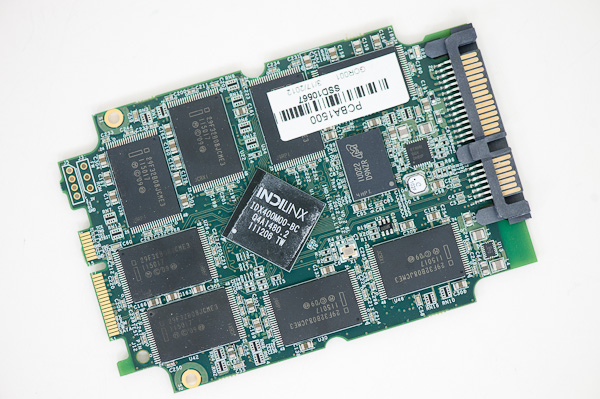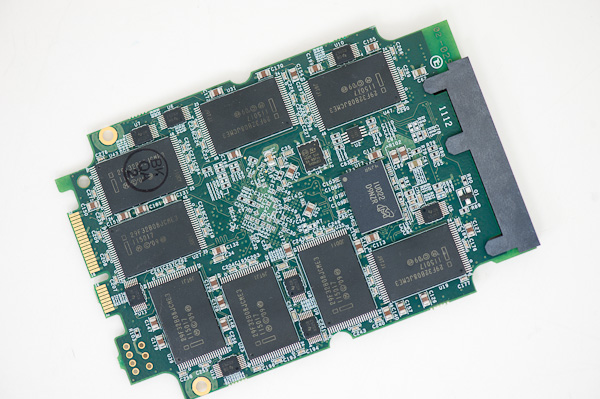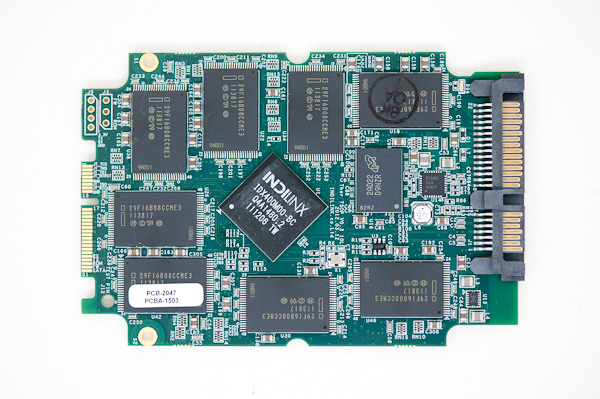OCZ Vertex 4 Review (256GB, 512GB)
by Anand Lal Shimpi on April 4, 2012 9:00 AM ESTInside the Vertex 4
At a high level, Everest 2 is architecturally very similar to its predecessor. The SoC is still built on a 65nm G process and maintains the same basic architecture. Clock speeds are up now from 333MHz to 400MHz. There are also microarchitectural tweaks at work here – limits in Everest 1 have since been removed for Everest 2. Everest 2's sequencer is much improved, but getting more detail than this is basically impossible.

Everest 1's Block Diagram, Similar to Everest 2
Just as with previous OCZ drives, the Vertex 4 ships with its own custom designed PCB. Unlike most SSDs we've seen, the Vertex 4 places its Everest 2 controller in the center of the PCB – with NAND fanning out in a circle around it. The Indilinx SoC uses the drive housing as a heatsink as two thermal pads help conduct the heat away from the chip:
In the 512GB version we find quad-die packaged Intel 25nm synchronous MLC NAND devices, sixteen of them in total. The 256GB version keeps the same number of devices but drops the die count per package from 4 to 2. Despite launching with Intel NAND, OCZ claims broad support for Flash from other vendors. Touting that advantage really only matters if there's cheaper NAND available on the market, today Intel NAND is still priced competitively enough to make it an obvious fit.
OCZ is currently testing 20nm Intel NAND and 24nm Toggle Mode NAND with the Everest 2. Both are functional at this point, but neither is optimized in the current firmware. Should Toggle Mode NAND pricing or performance offer a measurable advantage, OCZ will introduce a separate product based on it. Currently, low-density 24nm Toggle NAND isn't price competitive and thus it's not used at launch. OCZ did add that a 1TB Vertex 4 would almost certainly use Toggle NAND as Toshiba's high-density pricing (64GB, octal die packages) is better than from IMFT these days. We're still at least a quarter away from seeing 20nm NAND used in volume, so enabling support for either of these options will require a firmware update.
With its sights fixed on OEMs, OCZ is far more concerned about drive longevity than it once was. OEMs don't like having to re-qualify components, they want a steady supply of the same product for the lifespan of whatever system they're selling. If a system is shipping to a government buyer, that lifespan can be extremely long. As a result, OCZ wanted to build a controller that was as forward looking as possible. Everest 2 needed to be able to migrate to 20nm without requiring another qualification pass from OCZ's customers. As NAND cell sizes shrink, error rates go up. Only so much can be dealt with at the NAND factory, the controller is extremely important to maintaining data validity.
The original Octane could correct up to 78 random bits for every 1KB of data using its BCH ECC engine. While that was more than sufficient for 25nm NAND, OCZ is planning for the future with Everest 2 and implemented a more robust ECC engine capable of correcting up to 128 random bits for every 1KB of data. OCZ believes the Everest 2's ECC capabilities are enough to ensure reliable operation with 20nm IMFT NAND and perhaps the first 1x-nm IMFT NAND as well. For consumers however, this has no bearing on the Vertex 4's performance/reliability as a drive today (Octane's ECC engine was enough).
1GB of DDR3-800 On-Board
The Everest 2 controller is flanked by a 512MB Micron DDR3-800 DRAM. Another 512MB chip exists on the flip side of the PCB bringing the total to a whopping 1GB of DDR3 memory on-board. OCZ makes no effort to hide the DRAM's purpose: Everest 2 will prefetch read requests from NAND into DRAM for quick servicing to the host. When serviced from DRAM, reads should complete as fast as the interface will allow it – in other words, the limit is the 6Gbps SATA interface, not the SSD.
In order to get 128GB, 256GB and 512GB drives to market as quickly as possible, OCZ is shipping them all with 1GB of DRAM on-board. The 128GB and 256GB drives simply won't use all of the DRAM however. A future revision of the Vertex 4 will pair the 128/256GB drives with 512MB of memory instead to save on costs.
The amount of memory bandwidth offered to the Everest 2 controller is insane – we're talking about 3.2GB/s, as much as many modern day smartphone SoCs, and as much as a desktop PC had a decade ago.
OCZ wouldn't tell me if the costs of shipping 1GB of DDR3 memory outweigh the savings from not having to pay SandForce for silicon anymore. Even though it owns Indilinx, R&D and manufacturing aren't free. All of that factored in, the cost of the Everest 2 controller is likely cheaper than SandForce's 2281, but it's not clear to me if the added cost of DRAM offsets that gap. None of this matters to end users, but it's an interesting discussion regardless. OCZ will have to deliver aggressive pricing regardless of its internal cost structure.
AES-256 Encryption
Similar to the Octane/Everest 1, all data written to NAND in the Vertex 4 goes through Everest 2's 256-bit AES encryption engine. Modern SSDs scramble data before writing to NAND to begin with (certain data patterns are more prone to errors in flash than others) and encryption offers security benefits in addition to working as a good scrambling engine. If you're going to support scrambling, the jump to enabling encryption isn't all that far.
Similar to other SSDs, the Vertex 4's encryption key is generated randomly at the factory. Unfortunately, also similar to other SSDs, there's no client facing tool to reset or manage the key. I believe the key is regenerated upon a secure erase and it can be tied to an ATA password, however what I'd really like to see is the bundling of a software package that can allow users to generate a new key and require a password at boot (not all ATA password implementations are super secure). I know there are third party applications that offer this functionality today, but I'd like to see something ship with one of these FDE drives by default so more consumers can actually use the feature. There's no point to having a self encrypting drive that gives up your data as soon as you plug it in to another system. While I'm making requests, I'd also like to see a way for OS X users to take advantage of built in full disk encryption.
Ndurance 2.0 and a 5-year Warranty
With Everest 2 OCZ supports redundant NAND arrays, similar to the latest Intel and SandForce controllers. By including redundant NAND on-board, the drive could withstand the failure of more than a single die without any data loss. The Vertex 4 doesn't have OCZ's redundant NAND technology enabled, although the enterprise version of the drive (Intrepid 3) will likely turn it on.

OCZ is also doing some granular manipulation of voltages at the NAND level in order to get the most endurance out of these drives (not all NAND is created equally, adjusting to characteristics of individual NAND devices can lead to more p/e cycles out of the drive). While this isn't really a concern for 25nm NAND on the Vertex 4 today, it is likely a feature we'll see played up with the move to 20nm and for eMLC versions of the drive targeted at the enterprise.
Confidence in reliability is at an all-time high with the Vertex 4 as it ships with a 5-year warranty, up from 3 years with the Octane, Vertex 2 and Vertex 3.















127 Comments
View All Comments
vol7ron - Wednesday, April 4, 2012 - link
Exactly, and it's where power consumption matters even more.I'd also like to see where the OWC drives fit in.
ViviTheMage - Wednesday, April 4, 2012 - link
There are plenty of lower pwer SSD's that have similiar tasty iops, so you won't be disappointed...the falvouring is a little different, but you will still enjoy it.ckryan - Wednesday, April 4, 2012 - link
I very much expect the next generation of Marvell drives to look similar in some respects to the V4.I applaud OCZ for doing things differently, but they're probably just trying to beat the next wave of Marvell powered drives to market, not making up for SFs immediate deficiencies.
ViviTheMage - Wednesday, April 4, 2012 - link
Do you think Marvell can release a drive with as many delicious iops?Kristian Vättö - Wednesday, April 4, 2012 - link
Not Marvell, because they only make controllers ;-)Plextor M3 Pro is already providing up to 75K/69K IOPS (read/write). Marvell released a new controller a couple of weeks ago and at least according to the press release, random speeds should be substantially improved with a great firmware. How fast is still a question but I wouldn't be surprised to see figures similar to Indilinx 2.
And as a side note, Plextor M3 review should be up later today or tomorrow as well :-)
ckryan - Wednesday, April 4, 2012 - link
The M3P is fantastic. It's like the V4 without the compromise. Plus, I'd take better low QD performance any day of the week over high QD performance. The M3P is a lot more balanced.Plus, yeah, the 830 is awesome too, but it doesn't really cater to the super high 4Krw crowd. I feel like OCZ just needed to get this drive out before then next wave of similar drives hit, and will later tweak the FW to better accommodate desktop workloads.
But it does accomplish one thing -- whatever FW/FTL they strapped on that drive doesn't look like anything else at the moment. It's certainly easy to see in an ocean of charts.
I think OCZ just mainly wanted to reverse their years of SF marketing practice with the V4 -- Latency is now important. Compressible data is out. They just had to wait until they had a product that could match the paper specs of the 2281. Ironically, I'd take it over a V3 any day of the week, but the 2281 is still better with most workloads.
etamin - Wednesday, April 4, 2012 - link
Perhaps the V4 may turn out to be a more economical choice though because it is entirely developed in house.jwilliams4200 - Thursday, April 5, 2012 - link
LOL. Except for the rebadged Marvell controller and the flash memory, yeah, entirely in house.rw1986 - Friday, April 6, 2012 - link
rebadged MRVL controller?? can u elaboratejwilliams4200 - Friday, April 6, 2012 - link
Did you ever wonder why Indilinx took so long to come out with a 2nd gen controller after their first was so popular?Well, they didn't. Not really. OCZ does not want you to know that they have a relationship with Marvell, and their new controller is basically a Marvell 88SS9187. It would be hard to justify the shareholder money OCZ spent on acquiring Indilinx if the truth were known.
If you have any doubts, look at the press release from Marvell press release bullet points and compare them to the features OCZ is touting in the Vertex 4. They are identical.
http://www.marvell.com/company/news/pressDetail.do...